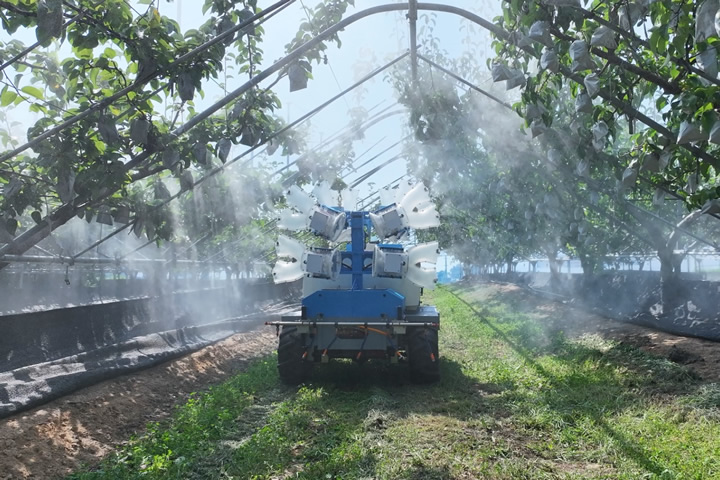Purigo - Unmanned Orchard Spraying Robot

This electric robot performs the same spraying tasks with only 15.1% of the power (59.5 kW for conventional sprayers, 9 kW for Purigo), consuming six times less energy than traditional systems. Through this innovation, Purigo has achieved unprecedented energy-saving technology and successfully transitioned to eco-friendly electric technology, dramatically reducing operational energy. Purigo sets a new standard for orchard management and paves the way for the future of sustainable agriculture.
Purigo’s energy-saving technology is realized through two major engineering innovations. First, the distance between all spray nozzles and the crops has been significantly minimized compared to traditional methods, and an independent blower system for each nozzle replaces the conventional integrated blower, reducing energy waste. Second, the conventional fossil fuel-based, heavy-weight powertrain and central blower system have been replaced, reducing the weight of the sprayer by 49.5% (from 1,395 kg to 705 kg), further conserving operating energy.
Additionally, the ground-based Purigo Spraying Robot offers greater efficiency than drones, thanks to its large tank capacity of over 500 liters, extended operating time of 5 hours, precise close-range spraying, lower susceptibility to weather conditions, reduced chemical drift, and cost-effectiveness. For large-scale orchards, Purigo provides minimal downtime (for refilling or battery charging) and ensures consistent and precise chemical application.

Purigo is compatible with most diluted liquid pesticides (including water-soluble and suspension concentrates), except for solid formulations such as GM, offering a wide range of applications.
The Purigo Spraying Robot features a compact design that reduces its size by 17% (from 6.24 m³ to 5.18 m³) compared to conventional sprayers by eliminating the need for a driver's seat. This makes it suitable for a variety of orchards, and its reduced size offers over 200 liters of trunk space for storing agricultural materials and equipment. Purigo also actively pursues ESG goals by incorporating components that minimize the use of plastics, such as water tanks. For safety, ultrasonic sensors and collision sensors are mounted on both the front and rear of the robot to prevent accidents, while the control box is positioned on the front side for improved maintainability. The robot also features front and rear cameras, allowing manual operation via a wireless controller while viewing the driving footage.
The Purigo Spraying Robot not only reduces energy consumption by six times, but it also significantly reduces the weight and size of the product, minimizes the use of plastics and pesticide waste, and contributes to environmental protection in innovative ways. Moreover, its autonomous operation minimizes exposure to harmful pesticides, enhancing worker safety during operation. Despite its technological advancements, the robot remains competitively priced compared to traditional equipment, providing broad market accessibility. Additionally, the originality of its technology has been officially recognized through domestic patent applications and international PCT filings.
Opportunities to see the Purigo Spraying Robot in person will also be available. In South Korea, the first public demonstration will take place at the Daegu International Agricultural Machinery Exhibition (KIEMSTA) starting on October 30, 2024, and in the United States, it will be showcased at CES 2025 in January 2025. These exhibitions provide an excellent opportunity to experience Purigo’s cutting-edge technology and performance firsthand.
Comments (0)
This post does not have any comments. Be the first to leave a comment below.
Featured Product

igus® - Free heavy-duty plastic bearings sample box
The iglide® heavy-duty sample box provides a selection of five unique iglide bearings, each suitable for use in heavy-duty equipment due to their self-lubricating, dirt-resistant properties. Each bearing material boasts unique benefits and is best suited for different application conditions, though each can withstand surface pressures of at least 11,603 psi at 68°F.
